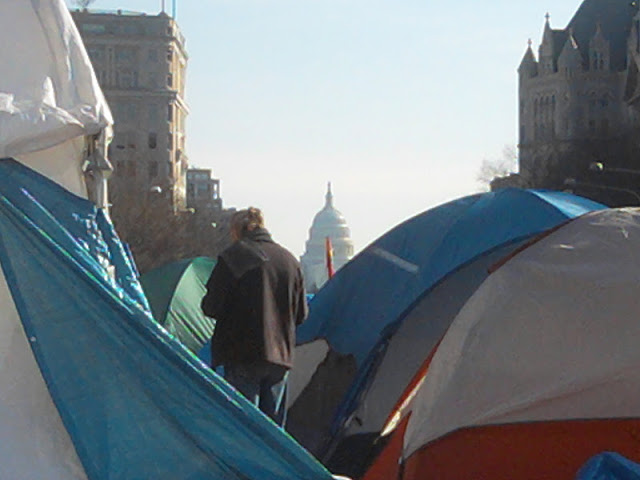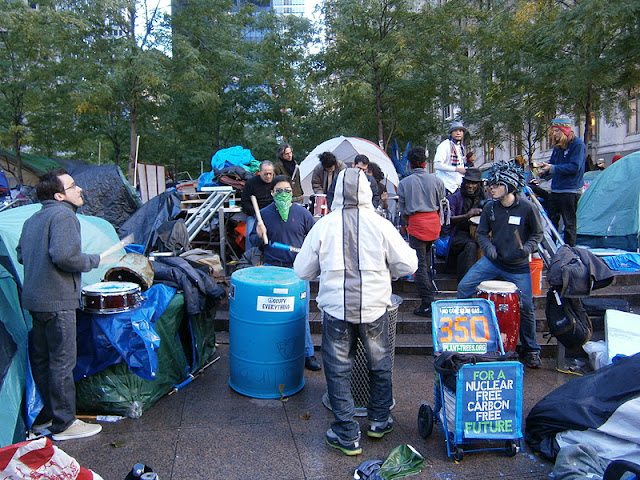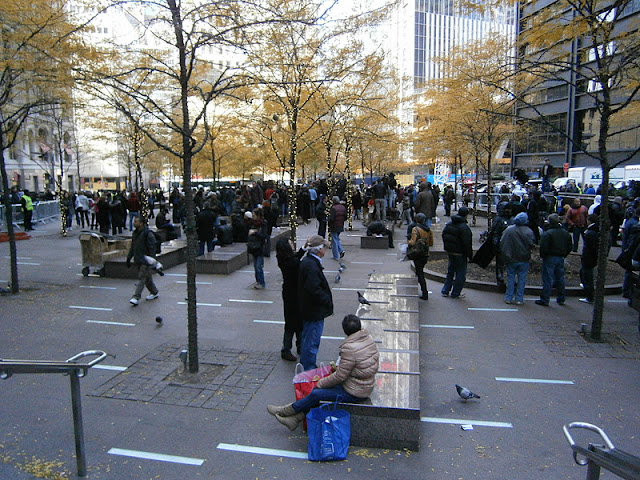A sunny Sunday stroll through Lower Manhattan this past weekend revealed nothing less than an American awakening. And that is not an understatement after seeing the rapidly rebuilding Ground Zero site and the nearby
Occupy Wall Street demonstrations at Zuccotti Park. It is appropriate that ground zero of the people-powered movement to reclaim the American dream following the worst economic collapse since the Great Depression is literally right across the street from the newly opened
9/11 Memorial that commemorates the worst attack on American soil since Pearl Harbor.
There is an undeniable connection between the 2001 terrorist attacks and the 2008 economic collapse. And I'm happy to report that, despite claims to the contrary, American Democracy is not dead thanks to the courageous souls taking a stand for the 99% of us. And America's collective spirit to do big things is alive and well thank you very much, despite the political paralysis and short-term thinking on Capitol Hill. That's because gleaming new skyscrapers are arising from the ashes of 9/11.
New York is resilient. New York is not afraid of embracing the future. New York is America, not the self-centered, small-minded politicians in Congress. Thank God for that. Ground Zero and Zuccotti Park should give us all hope that all is not lost in this country we all love so dearly but are rightly so concerned about.
GROUND ZERO
The first sign of progress most visitors notice upon a visit to Ground Zero is
One World Trade Center -- the formerly named Freedom Tower is being built up at a furious pace and when completed in 2013 will tower over the New York City skyline as the tallest building in the United States and one of the tallest skyscrapers in the world.
And there are other towers under construction such as
Two World Trade Center as well as the 9/11 Museum which is scheduled to open a year from now. The 9/11 Memorial Fountain recently opened to the public on the tenth anniversary of the attacks and has already become a popular tourist attraction, although it should be noted that you need to reserve tickets online in advance to enter the memorial area. I didn't reserve a ticket so the photos I took are from the outer perimeter of the memorial. Also, the
World Trade Center Transportation Hub is expected to be completed in 2014.
For many, the lack of progress in rebuilding Ground Zero was a symbol of this country's misplaced priorities and political inertia. How else to explain that in the past decade the New York Mets, Yankees, Giants and Jets all received shiny new stadiums, the Nets will be moving to a new arena in Brooklyn and the home of the Rangers and Knicks, Madison Square Garden, just underwent an $850 million renovation while train travelers have to suffer underneath MSG in a cramped and dingy Penn Station?
But now that there is visible progress at Ground Zero there is hope that at least New York City can rebuild its infrastructure for the 21st century and showcase big and bold architecture and grand public spaces. With the Senate today blocking President Obama's $60 billion infrastructure plan, which should have been a bipartisan slam dunk, it is obvious the political will is lacking on Capitol Hill. But after seeing what is being done at Ground Zero, there is even hope that eventually, likely with a few election cycles to get the current unimpressive group out of office, that our national political leaders can show the same collective determination and vision as the planners of the Ground Zero rebuild have.
OCCUPY WALL STREET
Which brings us to Occupy Wall Street, because in order to give the boot to the political charlatans on Capitol Hill the movement needs to grow even bigger and turn into a potent force able to rally millions of Americans to vote at the polls for candidates who will invest in clean energy, health care, education, transportation, infrastructure and innovation and strengthen the middle class while addressing the unsustainable growing gap between the rich and poor.
The encampment at Zuccotti Park has become a big tourist attraction and on the day I visited there was a festive atmosphere with drum beating and other music, lots of creative and heartfelt signs and even an innovative
bicycle-powered generator providing heat and electricity to the tent dwellers.
There are a couple of observations I've noticed walking through both the Occupy D.C. and Occupy Wall Street encampments. Number one is how organized and resourceful they are. Call it organized chaos if you'd like. It might seem like these are a bunch of dirty hippies dancing in a drum circle, but a closer inspection reveals that this movement is highly organized. There is a daily schedule of activities, including workshops and marches. There are Occupy newspapers being printed to inform demonstrators and the public. At Zuccotti Park there is even a makeshift library with all sorts of books in plastic bins. And when I was there people were patiently waiting in line for healthy lunches. An example of the resourcefulness is the aforementioned bike-powered generator, which was started by the Sustainability Working Group after the NY Fire Department and NY Police Department confiscated six gas and diesel generators because of safety concerns.

The second observation is that the people living in these tent cities, whether it is McPherson Square or Zuccotti Park, are taking extra measures to tend to the park. There are signs warning visitors not to touch the flowers or tread on newly seeded grass. There are trash and recycling bins set up. These two parks are probably in better shape now with the encampments than before the demonstrators arrived.
The bottom line is that these people are sick and tired of being sick and tired so they are taking a stand for all of us. It is no different than the civil rights movement or any other progressive movement that made our lives better. For that, we should all be thanking these people.
While I was walking around Zuccottti, some guy walking by said "go home hippies." One of the demonstrators, a young woman, responded that "we are home." I wonder if one day this guy will realize he is the 99% too and will join them.
Here are more photos of One World Trade Center and the 9/11 Memorial and more photos of Occupy Wall Street.
Get the flash player here: http://www.adobe.com/flashplayer
Get the flash player here: http://www.adobe.com/flashplayer
And here are videos I took at Zuccotti Park. The first video is of a musical tandem singing a snappy folk song that could be the theme song for Occupy Wall Street. I didn't catch the name of their group. The second video is a bit of the scene last Sunday as I walked around.


















































